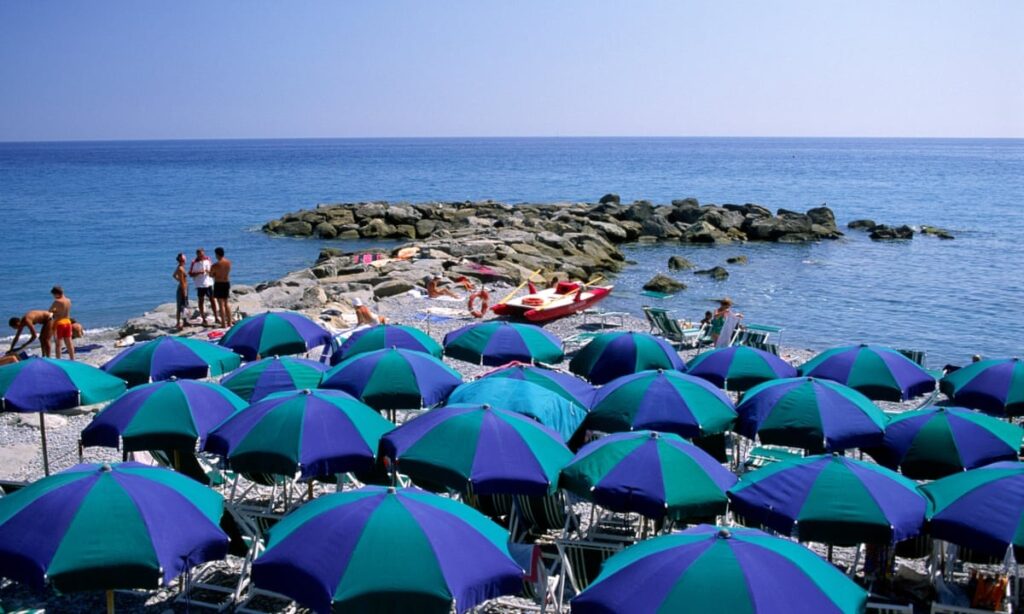
Lavish mansions, delightful cuisine, lush gardens, and serene shores lured British expatriates to Bordighera in the 1880s – and it remains equally captivating today
While my wife and daughter found shade beneath a parasol on Bordighera’s beach, my teenage son and I embarked on a quest to find Western Europe’s largest Ficus macrophylla. This renowned tree, also known as the strangler fig, was planted in 1886 by Clarence Bicknell, a British botanist, collector, Esperanto enthusiast, and chaplain of Bordighera’s Anglican church.
Bicknell held a deep affection for the hilly, pine-clad coastline stretching from Sanremo to the French Riviera. However, he developed a strong aversion to his “tea-party-loving, gossip-prone” British congregation, whom he believed lacked an international outlook. Consequently, he resigned from his church duties and devoted his time to painting flowers, documenting archaeological artifacts, and creating rubbings of prehistoric rock carvings in the maritime Alps.
The Museo Bicknell now houses his entire legacy, which includes an extensive collection of butterflies, his sketchbooks, numerous pressed flowers, a microscope, and a sepiolite clay pipe. Additionally, the museum provides a window into Bordighera during the 1880s, a period when the British population exceeded 3,000, greatly outnumbering the local residents. They established Italy’s inaugural lawn tennis club within the resort and crafted exotic gardens around their opulent estates. The museum’s facade is adorned with an entwining wisteria that envelops the structure, draping it in vibrant purple blossoms each spring. Just outside the entrance gate stands a towering strangler fig, reaching a height of 21 meters, its aerial roots winding down from its branches, with a delicate palm tree sprouting amidst its buttress roots. Another colossal ficus tree can be found in the garden beyond, where pine trees, oleanders, lemon trees, and aloe plants burst through the surrounding fences.
Every path leads to shadowy squares with whitewashed walls and shaded restaurant tables
We stroll down Via Romana, passing the Art Nouveau Villa Regina Margherita (named after the same queen as the pizza) as we make our way to the historic medieval town, in pursuit of both water fountains and delectable ravioli.
Perched high above the coastline, the pentagon-shaped old town, known as città alta, is a labyrinth of caruggi (narrow streets) adorned with potted plants and bicycles adorned with flowers. Navigation here doesn’t require a map; every path leads to the same shaded squares enclosed by pale walls, boasting a handful of restaurant tables beneath the sheltering canopy.
Osteria Magiargè, for instance, offers exquisite ravioli options, including those stuffed with ossobuco complemented by saffron cream, or a herb-infused variety paired with butter and thyme. Just a short stroll away, La Cicala prepares green ravioli filled with eggplant served in a cherry tomato sauce, along with the local specialty of fried zucchini blossoms accompanied by burrata.
Within the old town, arcades and narrow passages maintain a refreshing ambiance, but the seafront promenade in Bordighera offers no respite from the sun. At its midpoint stands a weathered bandstand, a tribute to Evita Perón, who inaugurated the Lungomare Argentina during her visit in 1947. Flanking this promenade are ice cream parlors, bicycle rental shops (ideal for the flat ride to Sanremo, eight miles away), and restaurants perched on stilts over the beach.
Setting aside ravioli and brandacujun (creamed cod with olives and potatoes), Bordighera has gained fame for its delectable pastries. Therefore, we decide to grab a slice of chocolate and pear tart, along with another piece of apple and maraschino pastry, both from U Pesigu on Via Vittorio Emanuele. We also indulge in an ice cream in the charming shape of a hedgehog from a nearby gelateria, and then head down to the smooth pebble-strewn beach.
The beach still retains its summery ambiance, with parasols propped up and loungers laid out, yet there are scarcely any people occupying them.
My wife and daughter are keeping an eye on some bicycles while their owners take a dip in the sea. Tiziana and Tommaso have been pedaling along the Riviera dei Fiori, journeying from Genoa to Ventimiglia. “We’ve encountered so many charming places like Cervo and San Lorenzo al Mare, and we even had the incredible experience of spotting some whales,” says Tiziana. “However, Bordighera holds a special place in our hearts because of its lengthy promenade and the tranquil beach where you can enjoy a meal with a sea view.” Tommaso is looking forward to returning on Thursday for the clothing market. This morning, they explored Dolceacqua, nestled high in a valley that once inspired Claude Monet. Tomorrow, their adventure continues as they head to Menton, a town beloved by Queen Victoria.



